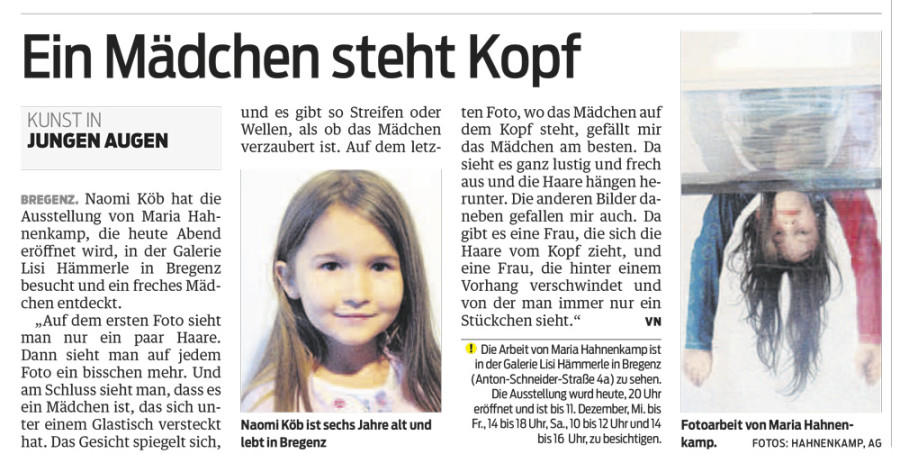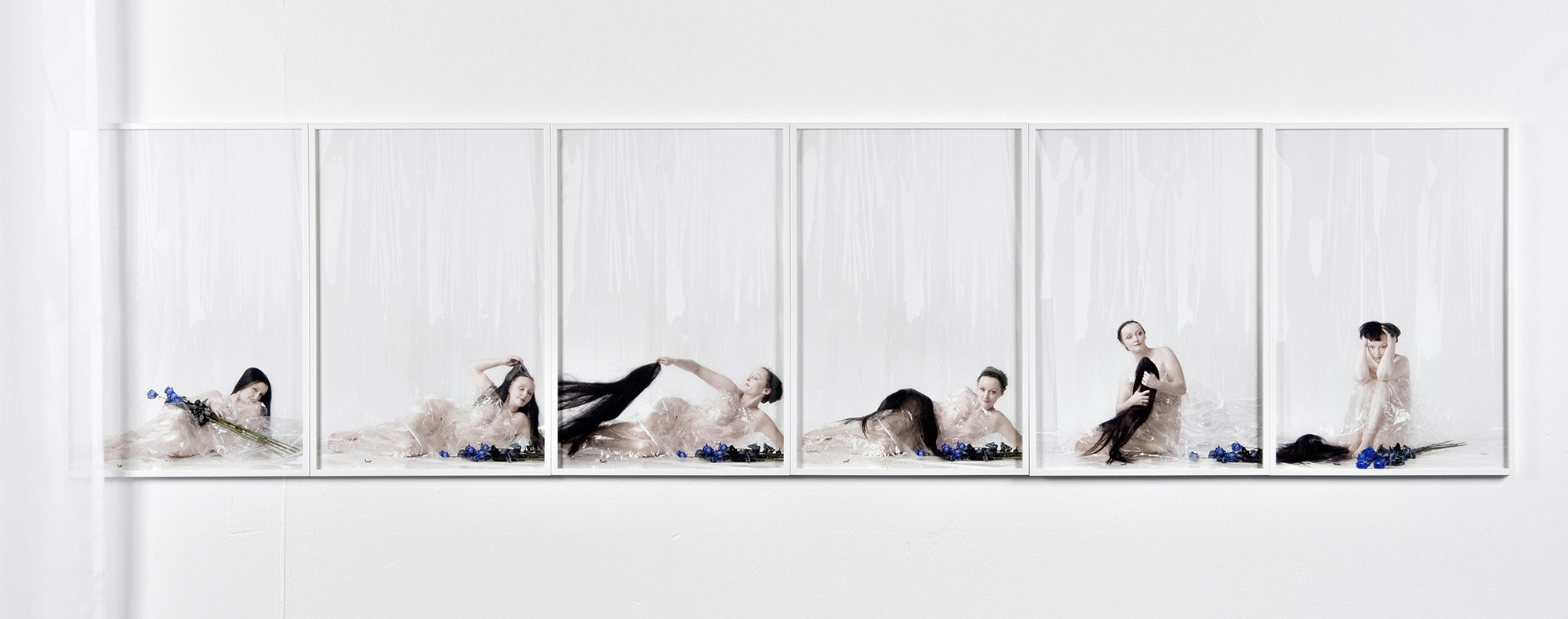Maria Hahnenkamp
13. November 2010 bis 8. Jänner 2011
Einführende Worte/Speaker: Silvia Eiblmayr
Maria Hahnenkamp beschäftigt sich mit dem Topos des weiblichen Körpers, mit den medialen Bildern der Werbe-, Schönheits- und Modeindustrie und auch mit den tradierten Bildern der Kunstgeschichte.
In ihrer Ausstellung in der Galerie Lisi Hämmerle arbeitet sie am Thema Porträt. Dieser Aspekt bildet in ihrer fotokonzeptuellen Arbeit eine spannende Weiterentwicklung insofern, als es in ihrer Auseinandersetzung mit dem medialen Bild immer darum geht, die scheinbare Identität, die ein fotografisches Abbild vermittelt, in Frage zu stellen. In diesem Sinn entsprechen die Porträts ihrer beiden Protagonistinnen, das siebenjährige Mädchen Laura und die Burgschauspielerin Regina Fritsch, nicht einem gängigen Schema in der Porträtfotografie. Sie bilden hingegen von der Künstlerin jeweils gestaltete Szenarios, in denen sie auf den Blick fokussiert, auf unsere oftmals unbewusste Form der Wahrnehmung eines Bildes, und in denen sie – in letzter Konsequenz – das „im Bild-Sein“ selbst thematisiert.
Auf einem Bild hockt Laura, aus einem Auge neugierig und ängstlich zugleich nach oben blickend unter einem ornamentalen Glastisch, der sie nur fragmentarisch sichtbar werden lässt und unter dem sie wie in einem Käfig eingesperrt erscheint. Ein ähnlich ambivalentes Spiel von Widerständigkeit und Anpassung, von Zeigen und Verbergen zeigt auch die andere Serie, wo sie auf dem Tisch liegt und mit dem Kopf nach unten hängend schrittweise ihre Haare, dann ihr Gesicht und ihre Arme sichtbar werden lässt.
Regina Fritsch, die Hahnenkamp bereits 2008 im Auftrag des Burgtheaters porträtiert hat, trug wichtige Accessoires für ihre Selbst-Inszenierung bei, eine Perücke mit langen Haaren und blau eingefärbte Rosen. Hahnenkamp zog für diese mise-en-scène eine durchsichtige Folie ein, die wie ein Vorhang das ganze Bild einnimmt. Sie hüllte die nackte Schauspielerin ebenfalls in durchsichtige Folie und ließ sie in diesem schmalen fotografischen Bühnenraum davor posieren, oder versetzte sie in einer anderen Serie, als Halbakt, vor und zugleich auch hinter den Vorhang. Zusätzlich zu dem Folien-„Schirm“, in dem sich das Licht verfängt und gleichsam blinde Flecken im Bild erzeugt, überlagert und erweitert sie die „Porträts“ mit weiteren Reflexionsebenen. Zum einen überträgt sie die „blinden Flecken“ auf ein paralleles Bild, um in diese Leerstellen fragmentarische Texte aus psychoanalytischem Kontext einzuschreiben; zum anderen bestickt die Künstlerin die Bildflächen mit einem Ornament, das sich wie ein strenges, wie ein immer schon vorhandenes Netz über die Bildoberfläche legt und ihre Protagonistinnen gleichsam unausweichlich in das Bild bannt.
Eine weitere Ebene schafft Hahnenkamp nochmals im Ausstellungsraum selbst, den sie – seine Architektur aufgreifend – mit Vorhängen inszeniert, und somit auch das Publikum in ihre Bildräume hinein holt.
Hahnenkamps Arbeiten handeln vom Prekären und der Verletzlichkeit menschlicher Existenz. In ihren „Porträts“ geht es um die Vielschichtigkeit eines (Ab)-Bildes und zugleich um das Bruchstückhafte, das immer auf ein Anderes verweist, das im Außen liegt. Sie zeigt, dass erst in der Beziehung zum Anderen, in der Beziehung zum Imaginären des Blicks und zum Symbolischen der Sprache, Identitäten entstehen; und sie zeigt, dass es kein vorgeblich komplettes Ganzes gibt, das die dargestellten Personen repräsentieren könnte. Die Kunst Maria Hahnenkamps liegt darin, dies mit konzeptueller wie auch ästhetischer und handwerklicher Vollkommenheit erfahrbar zu machen.
Silvia Eiblmayr
Maria Hahnenkamp works with the topos of the female body, with the media images from the advertising, beauty, and fashion industries, and the imagery passed down through art history.
In her exhibition at the Galerie Lisi Hämmerle, Hahnenkamp explores the theme of the portrait. This aspect is an exciting next step in her conceptual photographic work since her aim in exploring the media image is to question the apparent identity conveyed by a photographic representation. In this sense the portraits of her two protagonists – seven-year-old Laura and Burgtheater actress Regina Fritsch – do not fit into the ordinary scheme of portrait photography. Instead, they show scenarios composed by the artist in which she focuses on the view, on our way of perceiving an image, which is often subconscious, and in which the theme ultimately addressed is that of “being in the picture.”
In one photograph Laura sits on the floor. From beneath an ornamental glass table that reveals her only in part and under which she seems trapped as if in a cage, we see one eye looking up in a mix of curiosity and fear. A similarly ambivalent interplay between rebellion and conformity, between revealing and hiding, is expressed in another series in which she lies on the table with her head dangling downward, gradually slipping more and more over the edge, letting the viewer below see first hair, then face, then arms.
Fritsch, with whom Hahnenkamp had already worked in 2008, when the Burgtheater commissioned a portrait series of her, contributed important accessories to her self-staging: a long-haired wig and blue roses.
For this mise-en-scène Hahnenkamp used a sheet of transparent plastic that she hung across the whole set like a curtain. She also wrapped the nude actress in transparent plastic and had her pose in the narrow photographic space in front of the curtain. In another series we see the half-nude model partly in front and partly in back of the curtain. In addition to the plastic “shield” that reflects light, producing blind spots in the picture, she superimposes and expands the “portraits” with more reflection layers. The artist transfers these “blind spots” onto a parallel photo, inscribing fragmentary texts from psychoanalytical contexts into these empty spaces; at the same time she stitches a decorative pattern onto the image surface – like a web that has always been there – trapping her protagonists in the image.
Hahnenkamp’s work deals with the precariousness and vulnerability of human existence. In her “portraits” she addresses the complexity of a (re)presentation as well as its fragmentary aspect that always makes reference to the “other” that lies somewhere beyond. She shows that identities only emerge in their relation to the other, in their relation to the imaginary of the view and the symbolism of language. And she shows that there is no alleged complete whole to represent the people portrayed in the photos. Maria Hahnenkamp’s art lies the way she is able to make this experienceable on a conceptual and aesthetic level as well as in the perfection of the technical execution.
Maria Hahnenkamp – born in Eisenstadt in 1959, lives and works in Vienna. Since the late eighties Hahnenkamp has worked with photography and focused her attention on themes that revolve around the female image.
She received the Austrian Appreciation Award for Work in the Field of Artistic Photography from the Austrian Federal Ministry for Education, Arts and Culture in 2007 in recognition of her work that consistently focuses on the image of the woman and the relation between subject, body, and power. Maria Hahnenkamp’s work is both feminist and socio-critical. Her photographic analyses about presentation and representation, in particular in connection with the female body, were what determined the jury’s decision.
Silvia Eiblmayr

VN Kultur, 13./14. November 2010
